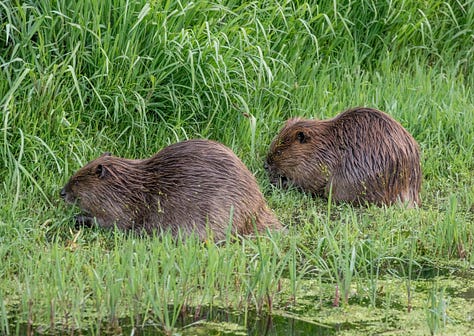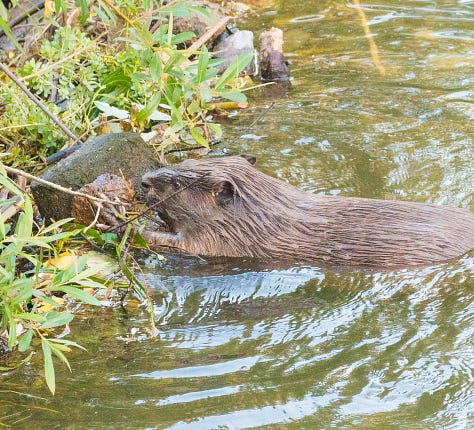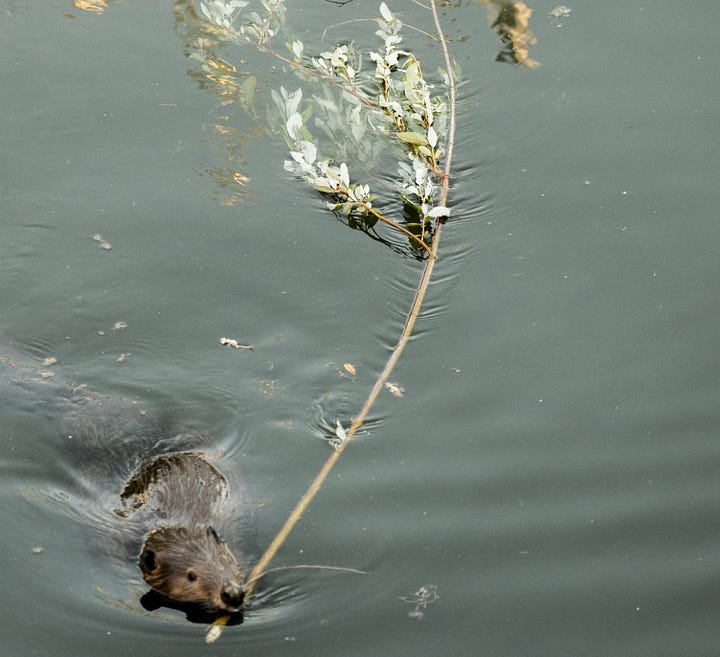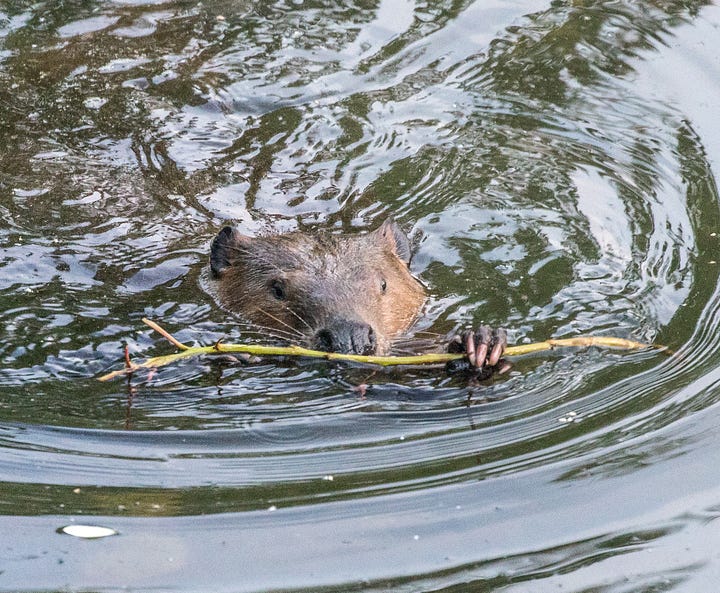Green Wednesday: Beavers' Comeback and Citrus Gardening Tips
By Kathleen Scavone, Environmental Contributor, and Drew Tomasyan, UC Master Gardener of Napa County
Support Napa Valley Features – Become a Paid Subscriber Today
If you’re reading this, you care about independent, locally owned, ad-free journalism — reporting that puts our region’s stories first, not corporate interests or clickbait.
As local newsrooms are increasingly bought by billionaires, scaled back or absorbed into media conglomerates, communities lose original reporting and are left with more syndicated content. Your support keeps quality regional journalism alive.
Join a community that values in-depth, independent reporting. Become a paid subscriber today — and if you already are, thank you. Help us grow by liking, commenting and sharing our work.
Green Wednesday: Gardening and Climate Insights
Every Wednesday Napa Valley Features brings you Green Wednesday, featuring articles from environmental voices and the UC Master Gardeners of Napa County. These contributors share research-based horticultural advice and insights on sustainability and climate topics relevant to our region.
Summary of Today’s Stories
"Beavers: Nature's Ecosystem Engineers" by Kathleen Scavone, Environmental Contributor: Beavers are making a resurgence in Napa County, playing a crucial role in restoring ecosystems by improving water quality, creating wildlife habitats and helping to mitigate climate change effects.
“Beavers are considered a keystone species since they play such a large part in the ecosystem.” — Kathleen Scavone
"Citrus Gardening in Napa Valley" by Drew Tomasyan, UC Master Gardener of Napa County: With Napa Valley’s climate well-suited for citrus, home gardeners can successfully grow oranges, lemons, mandarins and more by following proper planting, watering and mulching techniques.
“More citrus trees die from excess water than from drought.” — Drew Tomasyan
Beavers: Nature's Ecosystem Engineers
By Kathleen Scavone
NAPA VALLEY, Calif. — Beavers in wine country? You bet!
"In general, the beaver population is doing well in the Napa River watershed,” said Jeremy Sarrow with the Napa County Flood Control and Water Conservation District. “The number of dams and dens observed has at least doubled in the last decade. There are some local populations right here in downtown Napa on Napa Creek.”
Beavers are making a comeback throughout Napa County. They were once nearly extinct due to the fur trade of the 18th and 19th centuries. Since beavers were historically valuable for their fur and thought to be menacing creatures, they were shot or trapped regularly back then. They were hunted for meat, castoreum (a secretion used in perfume, medicine) and more. The highly informative book, “Napa Valley Historical Ecology Atlas: Exploring a Hidden Landscape of Transformation and Resilience” by Robin Grossinger, affirms that beavers were present in the Napa Valley as evidenced by accounts of early fur trappers in 1833. As in many other regions, beavers became scarce by the 1840s. However, beavers then as now were important to the watershed since the dams they built captured water that ensured summer stream function. The book explains that beavers are indeed back in the Napa River in Rutherford and Oak Knoll areas.





In his book entitled, “Bay Area Wildlife: An Irreverent Guide,” Jeff Miller writes that the Napa River is one of the best places to view beavers. Since they are aquatic as well as nocturnal animals, you will have more luck spotting them in the hours around dusk or dawn, but it's possible to locate some in daylight hours if you are “favored by the wildlife gods.”
Miller writes that there are clues to look for when beaver-spotting. You may hear the slap of their large, flat tail when it hits the water as it warns fellow beavers of nearby humans. You may note a beaver lodge constructed of mud and sticks. Or you might note small willows and other trees neatly chewed at the base. The root systems of trees are often left intact and can often regenerate. Beavers are herbivores since they dine on grasses, aquatic plants, tree bark and more.
This video by NBC Bay Area News shows beavers constructing a dam on Napa Creek at dusk.
If winter storms damage beaver dams, they will get to work rebuilding using their webbed hind feet productively. While swimming underwater, they make use of their special transparent eyelids to navigate the water. After their dam is constructed, they set to work on a den, or tunnel, to house a family. Beavers, who mate for life, typically give birth to between one and four kits, or baby beavers, in springtime. Youngsters retain family bonds by staying close to the parents for up to two years, often living to the ripe old age of 15.
“We usually get a beaver or two each year,” said Linnaea Furlong, Napa County's wildlife rescue manager. “They have come in with injuries or eye infections in the past. We also occasionally get beavers who get lost when the waters rise in a major rainstorm, then the waters subside, and the way a beaver reached an area doesn't exist anymore. There've been two cases like this that I remember. They ended up on suburban porches, not sure how to get back to the water they came from. These cases are a little easier, but we still need to track down where they came from so we can return them home.”
To determine where a beaver originated, Napa Wildlife Rescue often reaches out to folks who monitor beavers in the Napa community and asks if there have been any beaver sightings nearby. Usually, the beavers are not very far from their normal habitat, but perhaps a fence or road creates a barrier for their access back home. Next, they play beaver detective and look for signs of beavers, like chew marks or dams, and finally obtain permission to access property if needed to allow the beaver to go home.
Furlong says she finds her job interesting since she has the privilege of caring for many unique species and is always learning new things.
When transporting a beaver, Furlong says they “use a large dog airport transport style kennel with blankets or towels on the bottom for cushioning, and we cover the entire carrier with a blanket or sheet to reduce visual stimuli, because riding in a car is like being taken into an alien spaceship for wildlife, and seeing less tends to calm them down.”
To lure them into the carrier?
“If they are very debilitated, we just gently scoop them in,” Furlong explained. “If they are active, we put a kennel adjacent to the beaver in the enclosure and make it the most inviting place to escape from scary humans. We move our bodies to convince the beaver that the kennel is the right choice. They are powerful, but not very aggressive, so if you give them a way to move away and hide from you, they'll often take it. We also resign ourselves to the fact that the beaveris going to chew on the plastic of the kennel and possibly ruin it for future use. We have yet to have any beaver speedy, motivated and in a car long enough to chew out entirely, but they usually leave a mark on the kennel."
Napa Wildlife Rescue is holding their third annual open house where you can get the inside scoop on how and where they care for their temporary charges and animal ambassadors, including Maddie the red-tailed hawk, Odin the raven, Juniper the red-shouldered hawk and Blossom the opossum. The event is Saturday, March 8 from 11 a.m. to 1 p.m. at 4001 Middle Ave. in Napa.
There are a handful of self-described beaver advocates in Napa County.
Robin Ellison has been advocating for beavers in Napa County for ten years and has also volunteered for Napa Wildlife Rescue in the past. As part of her advocacy for beavers, she said, "I contact the California Department of Fish and Wildlife with a Public Records Act request for beaver depredation permits issued the prior year in the county." Next, she reaches out to permit holders to present them with information about beavers’ value to the environment. She said that folks are usually taken by surprise, not realizing that there is such a thing as a beaver advocate.
Napa County resident Rusty Cohn has become somewhat of a local celebrity due to his wonderful beaver photography. His interest in beavers was piqued when he noted a tree that had been chewed along Tulocay Creek. Next, he noted a beaver pond next to Hawthorne Suites Hotel which led him to conduct research on beavers, photograph them and become involved with an organization called Martinez Beavers, where he provides his photos and lends support to save beavers from eradication.
Why do beavers build dams? These semi aquatic rodents, who can weigh 50 pounds, build dams in lakes, ponds and rivers to keep safe from predators such as bears, coyotes and humans. They are extraordinary swimmers, but somewhat slow and clumsy on land which makes them vulnerable to prey. Using their sharp incisors, they cut vegetation such as small trees, and, together with mud and rocks, create their infrastructure.
These industrious, embattled rodents may steal your heart for the fantastic ecological benefits they perform.
Beavers are considered a keystone species since they play such a large part in the ecosystem. Their dams hold multiple roles, including improving water quality, restoring streams to their floodplains and creating ecological diversity by benefiting amphibians, fish and birdlife. Scientists are learning that when beavers construct dams, the water that dams retain aids in mitigating some of the disastrous effects of climate change including drought and wildland fires. Beaver dams sequester carbon while they add to both the groundwater and surface water storage.
Coexisting with beavers is not always easy for farmers and landowners since beavers may inadvertently cause flooding on the landscape by stopping up culverts or irrigation ditches.
To manage problems caused by beavers without killing the critters, Occidental Arts & Ecology Center in Sonoma County runs a large beaver restoration and coexistence program, and they have valuable information for Napa County residents. Their website includes great tips for beaver problems, provides case studies and offers courses as well. It explains that beavers are “nature's great ecosystem engineers,” and that beaver dams have near-magical capabilities to reconnect creeks to their floodplains, improve water quality and more.
These industrious, embattled rodents may steal your heart for the fantastic ecological benefits they perform. With education and perseverance, it appears that coexisting with beavers is a win-win situation. Beavers are garnering well-deserved respect for encouraging nature's diversity and a wealth of other wonders.
—
Kathleen Scavone, M.A., retired educator, is a potter, freelance writer and author of “Anderson Marsh State Historic Park: A Walking History, Prehistory, Flora, and Fauna Tour of a California State Park,” "People of the Water" and “Native Americans of Lake County.” She loves hiking, travel, photography and creating her single panel cartoon called Rupert.
Add Zing to Your Garden With Citrus
By Drew Tomasyan, UC Master Gardener of Napa County
NAPA VALLEY, Calif. — I love this time of year with the cool weather and refreshing rain. But I also love it for all the wonderful citrus fruit in stores and at farmers markets now. Bags of oranges, lemons, mandarin oranges, limes and tangerines are readily available everywhere.
Citrus is believed to be a native of China. Citrus fruits were first introduced to California in 1769, when the Spanish missionary and Franciscan priest Junipero Serra planted oranges and lemons at Mission San Diego. The first recorded citrus orchard was planted in 1804 at the San Gabriel Mission, and citrus trees were later grown at the missions from San Diego to San Jose.
Today California is the leading state in citrus production, accounting for 59% of the country's total citrus production. Most of California's citrus crop is eaten fresh; the state provides 80% of the nation's fresh citrus. Additionally, California grows 90% of the country's lemons.
Napa Valley's climate is well-suited to growing many types of citrus. Lemon trees yield fruit here year-round, while other types of citrus, such as Valencia and navel oranges, limes and mandarins, have specific harvest seasons. Home gardeners can plant citrus trees in their yards, on patios in pots, or as espaliers along walls or fences.
Citrus trees need well-drained soil and regular water. It’s a good practice to apply an organic mulch, such as compost, around citrus trees, but be sure to keep the mulch about a foot away from the trunk. The mulch will help moderate soil temperature and reduce heat radiation, which will help the tree tolerate hot weather. Mulch also helps conserve soil moisture by reducing evaporation, and it acts like a slow-release fertilizer as it breaks down.
Proper watering is important for citrus growth and fruit development. More citrus trees die from excess water than from drought. Over-irrigating or planting in slow-draining soil can doom your trees.
Because citrus trees are evergreen, they need water year-round. Demand for water is high when trees are actively growing, usually from late winter or early spring through summer, when drought stress can be a problem.
As for fertilizing, the primary nutrient the home gardener needs to supply is nitrogen. Phosphorus and potassium do not need replenishment often, if at all.
Citrus trees need little pruning. During the first two years, you may want to prune for shape, but most citrus trees develop an even, spherical form without any help. Pruning a mature tree can reduce fruit yields, but a light thinning of the top promotes growth of new fruitwood. Take care not to prune heavily, as citrus trees can suffer from sunburn.
Mulch provides a favorable environment for beneficial soil microbes while creating an inhospitable place for harmful organisms such as nematodes and Phytophthora, an organism that causes root rot. Aphids and mites can also bother citrus. Many of these pests can be controlled with strong blasts of water, insecticidal soap or horticultural oil.
Most citrus trees are self-pollinating, so they do not require pollinators such as bees. However, the blossoms have a sweet smell that attracts bees. No wonder the honey from nearby hives might have a citrus scent.
I think of lemons as being in a class by themselves within the citrus family. They are more frost-sensitive but do not need high heat to mature since they are not sweet. The Lisbon and Eureka varieties are the main supermarket lemons, but as a home gardener, my favorite lemon is Pink Lemonade. It is a sport of the Eureka lemon. Sports are genetic mutations that appear on only part of the tree, perhaps a branch or two. If they are considered favorable, breeders might choose to develop them as a new variety of the parent tree.
Pink Lemonade is a tart lemon, like the Eureka, but has pink flesh and green stripes on the skin. Leaves are green and white. It is not only beautiful but also easy to grow. I use it for lemonade, tarts, cookies and other sweets requiring a tart lemon.
Whatever citrus trees you choose to grow, you’ll find a lot more information online. Take a look at “Planting and Care of Young Citrus Trees” and UC’s pest management guide for citrus.
Events
Workshop: Join UC Master Gardeners of Napa County for a workshop on “Spring and Summer Vegetables” on Saturday, March 8, from 10 a.m. to noon at the University of California Cooperative Extension, 1710 Soscol Ave., Suite 4, Napa. Come get your hands dirty in this hands-on vegetable growing workshop. Learn what to plant now and what to plant later when the weather warms. Soil prep, irrigation, seed starting, transplanting and potential problems: We’ll cover it all. Click here to register.
Workshop: Join UC Master Gardeners of Napa County for a workshop on “Spring and Summer Vegetables” on Sunday, March 16, from 2 to 4 p.m., at Yountville Community Center, 6516 Washington St., Yountville. Come get your hands dirty in this hands-on vegetable-growing workshop. Learn what to plant now and what to plant later when the weather warms. Soil prep, irrigation, seed starting, transplanting and potential problems: We’ll cover it all. Click here to register.
Help Desk: The Master Gardener Help Desk is available to answer your garden questions on Mondays and Fridays from 10 a.m. until 1 p.m. at the University of California Cooperative Extension Office, 1710 Soscol Ave., Suite 4, Napa. Or send your questions to mastergardeners@countyofnapa.org. Include your name, address, phone number and a brief description of the problem. For best results attach a photo.
Drew Tomasyan is a UC Master Gardener of Napa County.
Today’s Polls
—


















I loved the article about Beavers and had reached out to a few folks about their resurgence when I moved to Napa last year. I also recommend a wonderful book, "Beaverland" by Leila Philip for a great history of beavers and their amazing positive impact on North America. Any possibility we could get a talk at the Library or some other place?
there are river otters also.